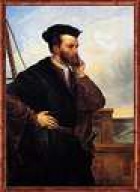Jacques Cartier

Jacques Cartier
World Explorer
Three Famous Voyages
Jacques Cartier was a french explorer who was born in St. Malo, France in 1491. The exact date of his birth is unknown. When Cartier was a kid he joined another famous explorer named Giovanni Da Verrazzano in 1524 on a Trans-Atlantic voyage. He was part of a family of famous mariners. Jacques Cartier was sent to Dieppe to learn how to be a navigator on ships. In 1520 he married Marry Catherine Des Granches. She was part of a family who owned many ships. Jacques Cartier is known for three famous voyages that discovered many things.
On April 20, 1534, Jacques Cartier set sail from St. Malo with 2 ships and 61 men. He was commanded by King Francois of France to search for a passage to a place called Cathay, either around or through the New World. If he couldn’t do this, he was to find Gold or riches like the Spanish had found in South America. On May 10th, Cartier arrived in Newfoundland and discovered an uninviting land. Cartier continued southwest and discovered the fertile land of Prince Edward Island. He believed it was part of the mainland. On one nearby island he and his crew shot over 1,000 birds including many Great Auks which did become extinct. Sailing on to the Strait Belle Isle near Newfoundland, He discovered the Gulf of the St. Lawrence river for the first time. He was about to go explore the river when a dense fog forced him to turn back. This is one of the things he is most famous for. On this trip he met for the first time the Micmac Indians. Their chiefs name was Donnacona. After making friends, Cartier ended up kidnaping his two sons and bringing them back to France. He learned much about the chief and the people from these two sons. The village the Indians lived in was called Kanata. So Cartier mapped and called the land Canada. And that was the birth of the name we call that country, Canada.
A year later after the first voyage, Cartier set out on his second voyage. In 1535 he had reached Hochelaga. Which is known as Montreal today. In the winter he tried to make it back to the Atlantic before ice blocked the St. Lawrence river which the Iroquois Indians had told him would happen. He made it only as far as Chief Donnacona’s village at Stadacona. Which is known as Quebec today. He had to spend the winter there. His men had made a small fort and Donnacona didn’t like that. Over the winter, Stadacona was hit by disease and scurvy. Donnacona blamed the French for all of this. By December, 50 natives had died and Cartier’s men were also suffering terribly from scurvy. Many became so sick they couldn’t work any more. But they were able to make enough noise by banging walls with tools to convince Donnacona that everything was fine inside the fort. Donnacona did not attack the fort because of this. Supplies were running low and many of his crew were near death from the cold and starvation. Cartier had discovered a simple cure for scurvy but never explained that in his journals. That was his second voyage to the New World.
After the second voyage, Cartier set out on a third. In May of 1541 he set sail with 5 ships and 1,500 men. His instructions were to settle the New World. Cartier would be followed by Jean-Francois de la Roucque de Robertval who would arrive with settlers, supplies and artillery so they could protect the new settlement. During his last 2 voyages, Cartier had discovered the St. Lawrence River and set up friendly relationships with the Iroquois Indians who lived on the river shores. Cartier did return Chief Donnacona’s sons after taking them back to France. This time again he got stranded by ice. He stayed at the small fort built by his men before. When the ice cleared, Cartier kidnaped the same two sons again, along with Chief Donnacona, three other Indians, and 4 children. He took them all back to France. All of them died in France except for one of the children. When he went back again he met the new Chief Agona. He explained that Donnacona had gotten sick and died. He also lied and said that all the others had become rich in France and decided to marry and stay there. Cartier made the Indians mad when he decided to abandon the fort at Stadcona. He built a new fort. He named that fort and settlement Charlesbourg-Royal. This was the first French settlement in North America. The Iroquois Indians kept attacking the new settlement. They made it difficult for the French settlers to enjoy life. Within 2 years, Charlesbourg-Royal would be abandoned. That was his third voyage.
Jacques Cartier started his last voyage back to France in the spring of 1542. He had made many discoveries and mapped new areas never explored before. On his ship going back he had what he thought was a huge supply of gold and diamonds from the shores of the St. Lawrence River. When he got back to France this time the King was very happy with the riches he had brought back with him. It turned out that the gold was fools gold and worthless. The diamonds were nothing but quartz rocks. So the King decided that Canada didn’t have anything to offer and he stopped sending explorers. Jacques Cartier retired to his home in St. Malo. He died there on September 1, 1557. He was 66 years old. He is remembered most for discovering the St. Lawrence River. He now has a River, Bridge and State Park named after him in Canada.
